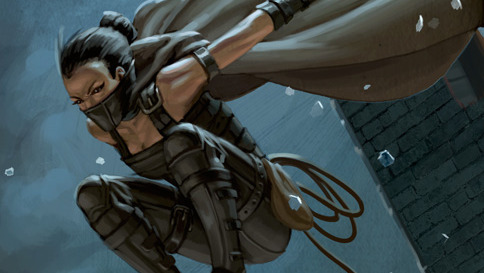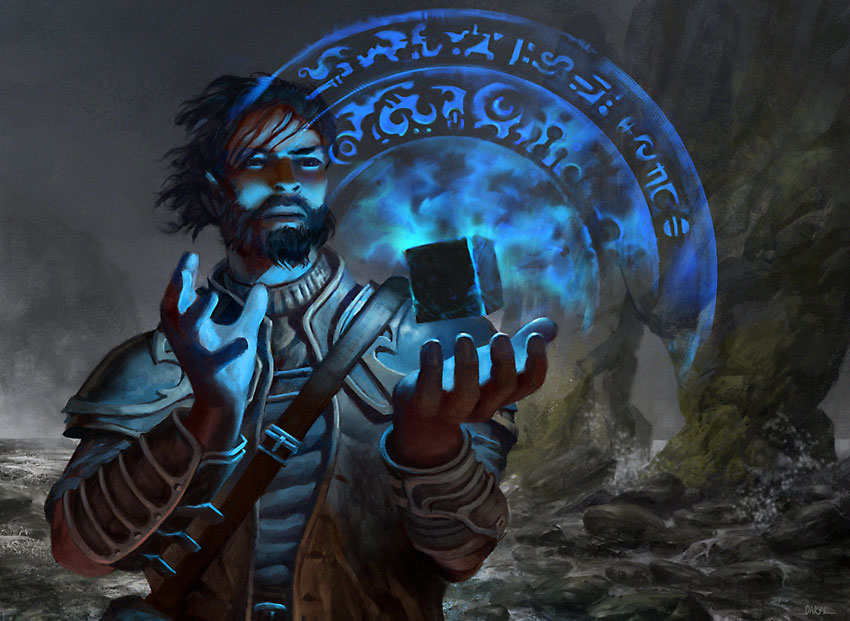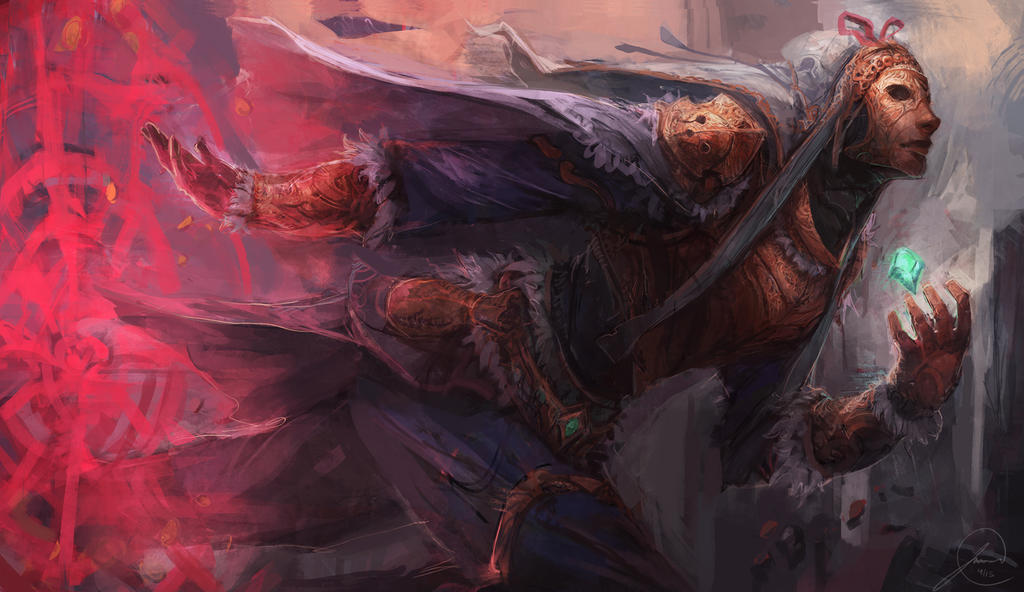Sneak Attack
 You are adept at finding and capitalising on the weaknesses of your enemies. An expert with ranged weapons and light blades, your strikes are lethal and precise. Not for you is the raging assault, but the slaughter born from patience. Even if your plans fall through or you find yourself overmatched, you can always fall back on your sharp wit and quick thinking to get out of sticky situations.
You are adept at finding and capitalising on the weaknesses of your enemies. An expert with ranged weapons and light blades, your strikes are lethal and precise. Not for you is the raging assault, but the slaughter born from patience. Even if your plans fall through or you find yourself overmatched, you can always fall back on your sharp wit and quick thinking to get out of sticky situations.
Your Hit Points per level rises by 1.
Your Skill Points per level rises by 3.
You gain a +1 bonus to Reflex.
When you hit an enemy that grants Combat Advantage to you with a weapon in the Light Weapons category, any damage you inflict is multiplied by 2. This does not include additional damage granted by Enchantments. This damage multiplier is applied after other damage multipliers, including critical hits. This bonus damage cannot be applied against enemies that are immune to critical hits.
Ability Synopsis
Sneak Attack is a classic ability of rogues and thieves, corsairs and assassins, cutthroats and ne'er-do-wells. Characters that benefit from Sneak Attack provide explosive damage and extreme utility to an adventuring party, with no single way to optimise or build.
The ability is drawn from the typical Rogue class, and its practical applications and Talents lean toward that (ig)noble heritage. Sneak Attack is great at deleting weaker enemies and capitalising on large scale boss battles. Sneak Attack holds the illustrious privilidge of being the only ability that grants a permanent damage multiplier, and as a result can be counted as one of the most powerful abilities in the game. To top it off, Sneak Attack is one of the few abilities that comes with 3 Skill Points per level. As a result, characters can put spare points into extra combat skills, defences, or a multitude of skills.
Sneak Attack comes with a few caveats that are reliant on game mechanics that are not immediately obvious, and finding a way around these caveats is key to utilising the effectively.
Combat Advantage is granted by unseen attacks, flanking a target, kicking a man while he's down, or similar debilitating effects. While a target grants Combat Advantage, any creature that tries to attack them can roll two dice and choose the higher one. For any additional cause of Combat Advantage, the attacker gains another dice. A man that is prone and being flanked grants two dice, for example. A flanked and prone man being attacked from a man on higher ground gets an additional three dice. This is a restriction that forces a character to fight cleverly, such as flanking targets with allies, abusing terrain advantages, or tripping opponents. On the other hand, Sneak Attacks are always made from a position of strength, and are both accurate and lethal. Whatever grants Combat Advantage also has Combat Disadvantage against its attackers. Disadvantage is, of course, to roll an additional dice and take the lower. This means a character is safer from retaliation, so long as the victim can stay at a disadvantage.
While double damage is a lethal effect, Sneak Attack can only use weapons in the Light Weapons category. This includes smaller blades, such as daggers, short swords, or rapiers, and most ranged weapons. Most of these weapons inflict Piercing damage, which can narrow their scope against targets resistant to piercing attacks. Infamous culprits include amorphs, skeletons, and constructs. There are no blunt light weapons, which means that these enemies are resistant to Sneak Attack regardless of your loadout. These enemies also tend to be immune to critical hits, which makes them very difficult to tackle for a Sneak Attack user. I would recommend characters to carry one blunt weapon and put a few points in it just for such an eventuality. You have skill points to spare, don't be afraid to sprinkle them around.
The ability is drawn from the typical Rogue class, and its practical applications and Talents lean toward that (ig)noble heritage. Sneak Attack is great at deleting weaker enemies and capitalising on large scale boss battles. Sneak Attack holds the illustrious privilidge of being the only ability that grants a permanent damage multiplier, and as a result can be counted as one of the most powerful abilities in the game. To top it off, Sneak Attack is one of the few abilities that comes with 3 Skill Points per level. As a result, characters can put spare points into extra combat skills, defences, or a multitude of skills.
Sneak Attack comes with a few caveats that are reliant on game mechanics that are not immediately obvious, and finding a way around these caveats is key to utilising the effectively.
Combat Advantage is granted by unseen attacks, flanking a target, kicking a man while he's down, or similar debilitating effects. While a target grants Combat Advantage, any creature that tries to attack them can roll two dice and choose the higher one. For any additional cause of Combat Advantage, the attacker gains another dice. A man that is prone and being flanked grants two dice, for example. A flanked and prone man being attacked from a man on higher ground gets an additional three dice. This is a restriction that forces a character to fight cleverly, such as flanking targets with allies, abusing terrain advantages, or tripping opponents. On the other hand, Sneak Attacks are always made from a position of strength, and are both accurate and lethal. Whatever grants Combat Advantage also has Combat Disadvantage against its attackers. Disadvantage is, of course, to roll an additional dice and take the lower. This means a character is safer from retaliation, so long as the victim can stay at a disadvantage.
While double damage is a lethal effect, Sneak Attack can only use weapons in the Light Weapons category. This includes smaller blades, such as daggers, short swords, or rapiers, and most ranged weapons. Most of these weapons inflict Piercing damage, which can narrow their scope against targets resistant to piercing attacks. Infamous culprits include amorphs, skeletons, and constructs. There are no blunt light weapons, which means that these enemies are resistant to Sneak Attack regardless of your loadout. These enemies also tend to be immune to critical hits, which makes them very difficult to tackle for a Sneak Attack user. I would recommend characters to carry one blunt weapon and put a few points in it just for such an eventuality. You have skill points to spare, don't be afraid to sprinkle them around.
Key Talents
Sneak Attack has two great strengths - damage and skill use. The Talents available to Sneak Attack focus on improving damage, expanding the use of skills, and making it easier to achieve Combat Advantage.
Assassin transforms the damage of Sneak Attack from a double to a triple, so long as you attack in a surprise round or from stealth. This is the trademark talent of snipers and one-shot killers, and is a huge increase in damage. Characters with ranged weapons tend to get more milage from this Talent than melee characters because it is easier to maintain cover or stealth at range. Because of the added requirement, this Talent is not an auto-pick for most characters. However, this Talent can work wonders for characters built to accomodate it.
Sniper supports Assassin very well, allowing to make a Stealth check to remain hidden after firing a ranged weapon. Essentially, this means the character can sit in the same spot and fire without being seen with free reign. Otherwise, a character must move, hide, and then attack. This is a time consuming strategy that, while great for remaining out of harms way, is slow.
Axeman, Swordsman, and Thug should be addressed together, as they allow single-handed Axes, Heavy Blades, and Maces respectively to be used with Sneak Attack. These weapons deal more damage that the standard fair found in Light Weapons, and they cover Piercing, Slashing, and Blunt damage types. However, these weapons are in the Heavy Weapons category, and use STR instead of DEX. This means that skills you may need, such as Stealth or Theivery, may be less potent if you chose to focus on STR instead of DEX. If you chose to increase both, then other important skills will be lacking.
Trapfinding is a classic Rogue skill that has become a Talent, and is the forerunner of at least eight other Talents that improve skills. It grants a +2 bonus to Perception, and allows you to reroll one dice to find hidden things or Insight checks to identify the properties of traps. This is the only Talent of its kind, and makes dungeoncrawling that much easier. All of the similar Talents also provide unique bonuses, ranging from making Stealth or Climb checks at full speed, to replacing the use of some skills to others, allowing you to maximise the efficiency of your skills.
Improved Trip, Improved Disarm, Improved Feint, and Improved Charge are on the General Talents list, but need to be addressed because of their usefulness to Sneak Attack. Trip and Disarm provide easy Combat Advantage and bonus attacks, but fall short against targets that cannot fall over or aren't carrying weapons. Feint can achieve the same end by providing a free attack, but does not provide any additional bonuses against targets that can be disarmed or fall over. Improved Charge requires a wind-up like a normal Charge, but grants Combat Advantage as well. If you Blitz instead of Charge, a dual-wielding character can murder an enemy in one flurry of knives and blood.
Recommended Builds
For all of its power, Sneak Attack is not particularly splashable. Instead, it does best work when paired with other abilities that help to provide Combat Advantage or build on skill bonuses.
When building a character around Sneak Attack it is best to do so that increases the likelihood of Combat Advantage. Shadow Affinity's Terror in the Dark grants constant Combat Advantage to the target of the Shade, guaranteeing Sneak Attacks without much difficulty. Shadow Affinity also has a selection of highly useful powers - Executioner's Noose can drag targets toward you or allow you to zip line to them, allowing for instant executions or spiderman style antics. Destroy the Light and Tenebrarum Rex can be used to set up zones of complete darkness in order to activate the bonus of Assassin, whereas Darkside offers raw damage in the form of another damage multiplier. Shadow Affinity also brings Slip Away with it, allowing for free Stealth skill checks in concealment, followed by free movement.
Bound Weapon provides stable damage that scales well with Sneak Attack, since the gradual damage upgrades count as quality upgrades rather than enchantments. However, other Talents that grant the likes of Axiomatic or Chaotic traits are still enchantments, and thus their damage is not doubled. Bound Weapon is better used for consistent damage, or taking Transform! multiple times to gain access to a variety of weapons with no draw time.
Bound Weapon provides stable damage that scales well with Sneak Attack, since the gradual damage upgrades count as quality upgrades rather than enchantments. However, other Talents that grant the likes of Axiomatic or Chaotic traits are still enchantments, and thus their damage is not doubled. Bound Weapon is better used for consistent damage, or taking Transform! multiple times to gain access to a variety of weapons with no draw time.
Rather than the typical sneaky play that Sneak Attack encourages, this particular combination of Character Abilities creates a vicious head on fighter with elements of tankiness. Dominate the Field grants access to Unbalancing Shove, which grants Combat Advantage whenever you Mark a target. In other words, since Dominate the Field Marks targets when you attack them, so long as you keep attacking the same target they grant Combat Advantage to you. Thus, you can Sneak Attack the target in every round after the first.
How you build from there is up to you. Take one of Axeman, Swordsman, or Thug to gain access to higher damage weapons and equip a shield to become tankier, or take advantage of Dominate the Field's punishing set of retaliation Talents and build for rapid strikes. Equipment Optimisation provides the opportunity for flat defence and damage increases, as well as a slew of skill related improvements. This also gives the option to gain some nifty Craft skill upgrades, allowing an amount of flexibility not usually associated with tanky characters. This includes attachments and augments, or gadgets available to Engineering crafts.
How you build from there is up to you. Take one of Axeman, Swordsman, or Thug to gain access to higher damage weapons and equip a shield to become tankier, or take advantage of Dominate the Field's punishing set of retaliation Talents and build for rapid strikes. Equipment Optimisation provides the opportunity for flat defence and damage increases, as well as a slew of skill related improvements. This also gives the option to gain some nifty Craft skill upgrades, allowing an amount of flexibility not usually associated with tanky characters. This includes attachments and augments, or gadgets available to Engineering crafts.
The Sneak Thief (Sneak Attack + Equipment Optimisation + Animal Companion)
Built for nought but utility, this combination of abilities grants the widest selection of skills and flexibility. Equipment Optimisation comes into play in a similar manner as the example above, but with less focus on the bonuses to gear and more on improved crafting. The ability to create gadgets with Engineering play up to the requirements of Sneak Attack, while poisons and potions made by Alchemy can make those attacks even more lethal. Combining the two can create some game-changing control effects - an adhesive blind grenade can shut down an encounter, or poison-tipped snares to immobilise and damage high health targets. Both such examples grant Combat Advantage and allow easy escapes if you become the target of the enemy's ire. Animal Companion emphasises mobility and strategic play. You can use your pet to flank enemies, and the Talents available to you either improve on that mobility or expand your skill bonuses. The Talents that improve skills under Animal Companion also improve your pet, thus many pets benefit from a similar playstyle to you. Combining all of these aspects together, this character relies on the setup for easy takedowns. Imagine scouting forward with an unnaturally sneaky wolf companion, scaling the walls at full speed without being seen, hanging from the rafters and dropping custom bombs on the enemy, then rapelling down to aid your allies in the cleanup operation. Or whatever, you can choose to find the treasure instead.
The Dashing Swordsman (Sneak Attack + Glamer + Bardic Song)
This particular set of abilities functions more as a supporting role with vicious melee capabilities rather than a backstabbing killer. Even without Talents, Glamer and Sneak Attack work seamlessly together. Glamer's power to alter a target's vision is unparalled, and provides both the opportunity to Sneak Attack and the ability to escape. Glamer also provides limited use of spells to compliment this swashbuckling playstyle, as does Bardic Song. These spells are limited to Illusion spells and a smattering of Enhancement spells, allowing you to pick and choose spells that compliment your fancies. Bardic Song provides the usual bonus to saving throws, and can be customised with different bonuses to best fit your party.
Bardic Song also has Talents very similar to Improved Trip and Improved Disarm, Footwork and Riposte respectfully. This is noteworthy because the effects of each stack, so successfully disarming or tripping a target awards two bonus attacks. Sneak Attack and Bardic Song also benefit from Talents that increase passive Reflex, so long as you wear cloth armour or no armour, so you remain very difficult to hit amongst the cut and thrust of the chaos you sow. However, all of these abilities only grant 1 Hit Point per level. So while this character offers damage, magic, support, and a huge range of utility, you are surprisingly fragile despite being difficult to hit.
Bardic Song also has Talents very similar to Improved Trip and Improved Disarm, Footwork and Riposte respectfully. This is noteworthy because the effects of each stack, so successfully disarming or tripping a target awards two bonus attacks. Sneak Attack and Bardic Song also benefit from Talents that increase passive Reflex, so long as you wear cloth armour or no armour, so you remain very difficult to hit amongst the cut and thrust of the chaos you sow. However, all of these abilities only grant 1 Hit Point per level. So while this character offers damage, magic, support, and a huge range of utility, you are surprisingly fragile despite being difficult to hit.







